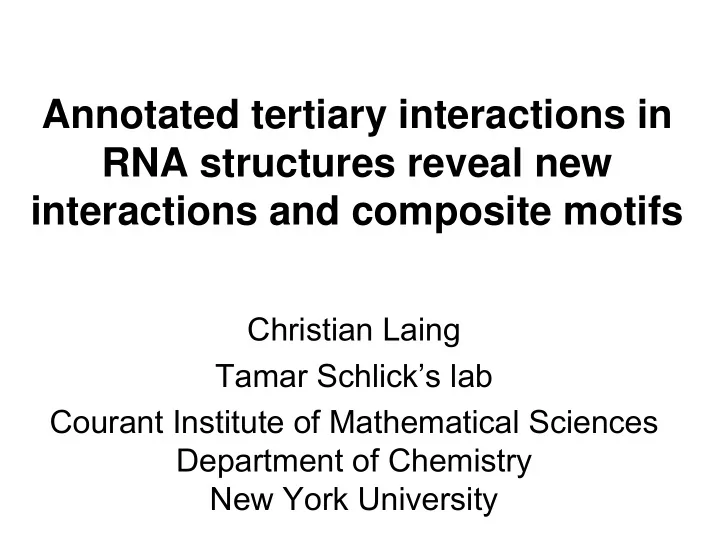

Annotated tertiary interactions in RNA structures reveal new interactions and composite motifs Christian Laing Tamar Schlick’s lab Courant Institute of Mathematical Sciences Department of Chemistry New York University
RNA folding is hierarchical Sequence Secondary Structure Annotated diagram 3D Structure 5‘gGACUCG GGGUGCCC UUCUGCGU GAAGGCUG AGAAAUAC CCGUAUCA CCUGAUCU GGAUAAUG CCAGCGUA GGGAAGUU c3' TPP riboswitch (PDB: 2GDI) • Tertiary motifs serve as modular building blocks in the RNA architecture. • To understand the role of RNA tertiary motifs in RNA folding will help to understand RNA 3D prediction.
RNA tertiary motifs Kissing hairpin Coaxial helix HIV-1 fragment (PDB: 1ZCI) JMB V.356 771 (2006) Pseudoknot Viral pseudoknot (PDB: 1L2X) PNAS USA V.99 4302 (2002)
Annotating 3D RNA • Selected seven key RNA tertiary motifs: coaxial helix, A-minor motif, ribose zipper, tetraloop-tetraloop receptor, pseudoknot, kissing hairpin, and tRNA D-loop:T-loop. • Searched RNA tertiary motifs via different computer programs • Annotate tertiary interaction motifs. • Perform analysis over the diagrams produced.
RNA dataset criteria • High resolution ( ≤ 3.0 Å) • Structure size (> 2 nt/strand) • Representative sequences (1) ( ≤ 55% sequence identity) • Structures should have at least one tertiary motif Final dataset: 54 RNA crystal structures • Use of RNAVIEW (2) , FR3D (3) , 3DNA (4) and RZparser (5) to annotate motifs (1) Hobohm U. et al. Protein Science 1:409-17 (1992) (4) Lu X. and Olson W. NAR 31:51088-21 (2003) (2) Yang et al. NAR; 31(13), 3450-60 (2003) (5) Tamura and Holbroook. JMB; 320(3), 455-74 (2002) (3) Sarver et al. JMB Jan;56(1-2):215-52 (2008)
Examples RNA junctions have a high probability (84%) to contain at least one coaxial helix.
23S rRNA PDB: 1VQO MOLL. CELL. V. 20 437 (2005)
23S rRNA PDB: 1VQO MOLL. CELL. V. 20 437 (2005)
Distribution of tertiary motifs tRNA D-loop;T-loop Kissing hairpin 6 7 (1%) (1%) Loop-loop receptor 16 (3%) Coaxial helix 182 Pseudoknot 40 (7%) (30%) Ribose zipper 121 (20%) A-minor motif 229 (38%) • For 54 high-resolution RNA structures, 601 RNA tertiary interactions were found. Most of them occur in the 16S and 23S rRNAs. • Ribose zippers, coaxial helices and A-minor interactions are highly abundant (88%).
A-minor involved in long-range interactions Structural context of the Watson-Crick pair in A- Structural context of the inserted A in A-minor minor 35 45 30 40 25 35 Percentage Percentage 30 20 25 15 20 10 15 10 5 5 0 0 Helix (WC) Helix (non- Internal Terminal Junction Other SS 1 2 3 4-5 WC) Helical context Structural context
Helices joint by long-range interactions 23S rRNA (PDB: 1VQO) MOL. CELL V.20 437 (2005)
Correlated motifs • Many A-minor motifs (64%) are involved with coaxial helices. • Coaxial helices (70%) interact with A-minor. • Most ribose zippers (70%) contain an A-minor. • Every loop-loop receptor contains a ribose zipper, which in turn contains one or more A-minor motif 87% Group I intron (PDB: 1HR2) RNA V.5 1119 (2001) of the time.
Summary and future work • The correlations observed suggest that RNA tertiary motifs work in a cooperative way between motifs and can form composite motifs. • To investigate the rules that allow prediction on interactions between motifs.
Acknowledgements Yurong Xin and Tamar Schlick Tamar Schlick’s Lab, NYU Human Frontier NSF/NIGMS initiative Science Program in Mathematical Biology (DMS-0201160)
Loop-loop receptor
A-minor and similar interactions
Recommend
More recommend